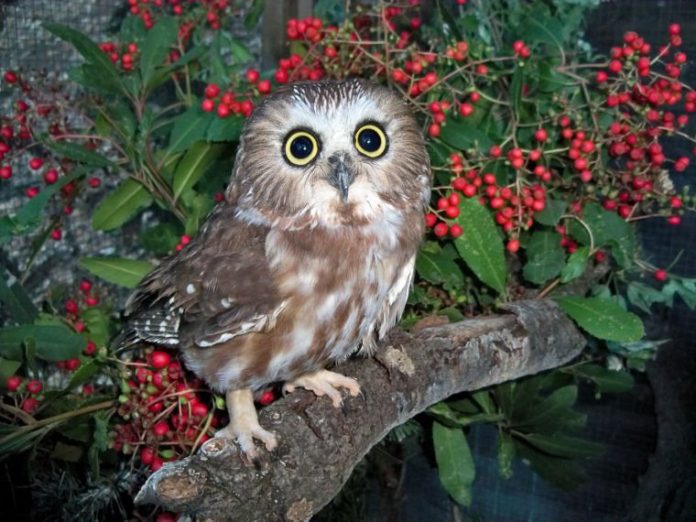Say hello to our little friend … a tiny northern saw-whet owl who has just joined the Wildlife Education and Rehabilitation Center’s educational animal ambassador team. It’s true that the best presents come in small packages!
It’s not known how the 7-inch owl was injured before it was rescued in July in Aptos and brought to Native Animal Rescue in Santa Cruz. Perhaps it hit a window or a vehicle while chasing a tasty rodent for its supper. NAR transferred the owl to Dr. Fern Van Sant at For the Birds (a bird hospital in San Jose), who examined it and provided emergency treatment. X-rays showed that its left wing was fractured at the wrist, causing the wing to droop. The wing was kept wrapped to aid in healing, but due to the location of the fracture and significant nerve damage, the poor little owl cannot fly, and can only hop from perch to perch. It will never be releasable. However, because of its young age and calm disposition, Van Sant contacted WERC to see if we would be interested in the owl for our educational programs. Indeed we were.
Non-releasable animals are invaluable for teaching the public about wildlife and the environment, but it’s a huge commitment that we make to the animal, which needs to be provided food, health care and shelter for the rest of its life. First, a veterinarian must certify the bird’s mental and physical health are good, despite the original injury that permanently incapacitated the animal. We then evaluate the bird to ensure that its personality is suitable to being around people. An enclosure must be built that meets minimum government requirements. The paperwork was sent to the U.S. Fish and Wildlife Service for approval to add the bird to our current educational permit. Permission was received Nov. 25 and the owl officially became a WERC ambassador and can be taken to schools and public events.
Northern saw-whet owls are one of the most common owls in woodland and forest habitats and range throughout most of the mainland United States and southern Alaska and Canada and central Mexico. But because they are so small, well-camouflaged and strictly nocturnal, they are very seldom seen, especially during breeding season when they nest inside old tree cavities drilled out by woodpeckers.
The little owls are fierce predators, rapaciously hunting small mammals at night from a low perch along the forest edge. The most common prey are shrews, mice, voles, bats and young pocket gophers, chipmunks and squirrels. They supplement their diet with small birds and large insects such as beetles, grasshoppers and moths. Large owls, such as great horned owls, long-eared owls and barred owls, are the most common predators of northern saw-whet owls, but loss of habitat due to urban encroachment is also responsible for their slowly declining population.
European explorers first discovered this owl in a North American colony called Acadia (now Nova Scotia). Their species name – aegolius acadicus – is Latin for “acadian owl.” The common name “saw-whet” comes from one of the owl’s unique calls which has been described as sounding like a raspy saw being sharpened on a whetting stone (“sh-whet sh-whet”). Another theory is that the name comes from the French-Canadian word “chouette,” meaning small owl. Normally, these owls only sing (a whistling “too-too-too-too” is another song) during breeding season, but WERC’s little owl thrills volunteers and children with its sweet vocalizations during the day. The saw-whet’s song is so eerie that it’s mentioned in the lyrics of the Grateful Dead’s “Unbroken Chain”: “Lilac rain, unbroken chain, song of the sawhet owl. Out on the mountain, it’ll drive you insane, listening to the winds howl.”
The saw-whet owl is called petite nyctale (little owl) in French and Lechucita cabezona (big-headed little owl) in Spanish. Some of its nicknames are acadian owl, the saw-filer, the sawyer, sparrow owl, farmland Owl, little nightbird and whet-saw owl.
But whatever you might call its species, this particular owl has spent the last five months without its very own name. Since we wanted the owl’s name to be suitably male or female – a DNA test was ordered that confirmed it’s a girl! – WERC is asking the public’s help in giving her a name and are holding a contest to find a fitting one for this cute and sweet little bird.
To participate, submit:
• A name! (as many as you want)
• Meaning or reason behind the name(s)
• Your name, email address and/or phone number (so we can tell you if you won).
Submit entries – preferably by email – to we**@*****ca.org with the subject line “Contest” or mail to PO Box 1105, Morgan Hill, Ca. 95038. Deadline is Jan. 3, 2014. Winning name (duplicates will be decided by earliest submission) will receive a one year sponsorship with personalized certificate, a WERC owl T-shirt and a surprise prize. Winner will be announced Jan. 10.













